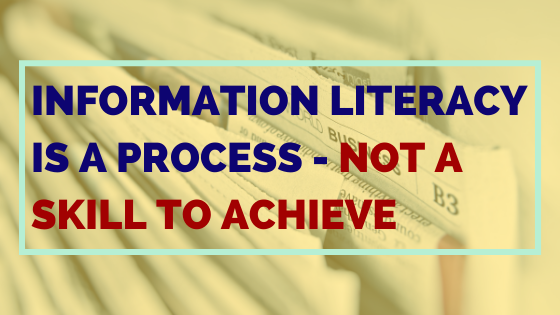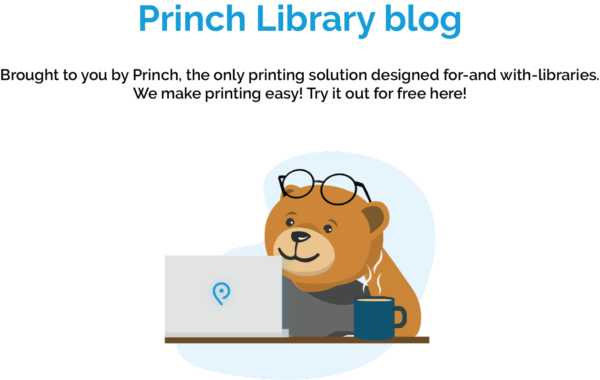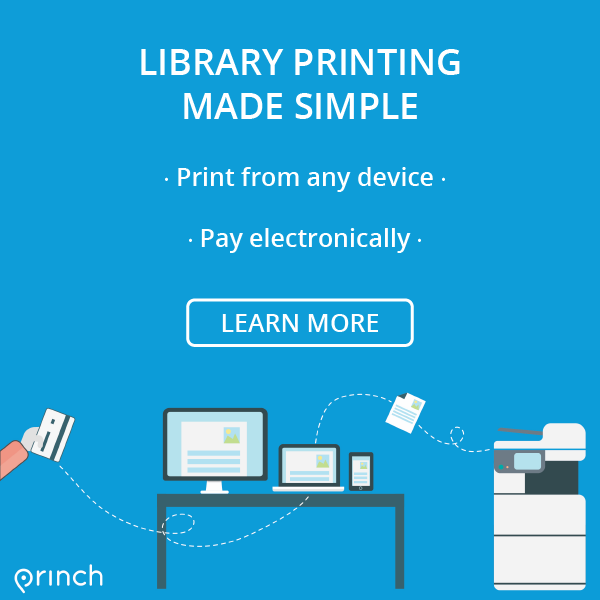Information Literacy plays a huge part in our everyday lives; with the amount of data bombarding us in every day, hour or even minute, it’s crucial for one to be able to navigate between the different, more or less reliable sources. However, this is not a skill you can just learn once, and then be set for the rest of your life – it is a process. Guest writers Jessica Kiebler and Amanda Piekart share their thoughts and experiences below.
If you read editorials online about information literacy, it often sounds as if the world’s communication problems could be fixed if only more students were taught the specific skills of how to use information properly. If only students could follow a checklist to evaluate an article or learn the “best” sources to go to for news and current events then the misinformation machine would stop humming. But those in the field of librarianship are learning more and more that information literacy is a process, not a set of skills to achieve, and are trying to spread that message through instruction and sharing their research.
Beginnings of IL
Information literacy (IL) instruction began as bibliographic instruction which was a way to teach people how to use the complex systems that were used to organize information, whether that was card catalogs or specific classification systems. As the systems we used to access information changed, instruction began to shift towards more general searching skills and the tools used to search such as online catalogs or databases. (Saunders & Wong, 2021). In the past decade or so, we have entered what Barbara Fister has coined, the Third Wave of information literacy, in which we are “just beginning to respond to the commercialization and portability of networked information” (Fister, 2019). This change in how people engage with information has also precipitated changes in how librarians view and assess our goals in IL instruction as the Association of College & Research Libraries (ACRL) Information Literacy Competency Standards for Higher Education, which were published in the year 2000, evolved into the ACRL Framework for Information Literacy for Higher Education in 2015. The Framework takes a more conceptual approach to what librarians teach in information literacy instruction and encourages the discussion of process, practices and metacognitive thought around information usage.
Adaptation to the methods
Librarians and information professionals should be shifting the way they think about IL instruction as our information ecosystem is no longer the same as it was in the days of the ACRL Standards or bibliographic instruction. Information is now quite easy to locate. A Google search brings back millions of results, however, this is not always the best or most accurate information. So librarians must spend less time on showing students how to conduct a search and more time on the critical thinking concepts related to changes in our information systems and new ways to evaluate information that don’t involve a website checklist. But don’t students still need to know all of the skills from the ACRL Standards? Yes! And by teaching about information literacy as a process through which their thinking will constantly evolve, students will still gain those skills, while also being able to engage with information more critically.
Students must understand that information comes in many more packages and containers than before. This is reflected in the recent update to MLA 8 and soon MLA 9 which provides a new way to construct citations based on the “container” concept (MLA.org, 2021). We are awakening to the need to expand the voices that are included in many conversations, especially in academia, to include those of BIPOC, women and LGBTQ+ scholars. In addition, evaluating for authority is much more complex with anyone being able to gain a platform and new forms of information that don’t fit the traditional authoritative standard. And at the same time, problematizing the traditional “gold standard” of peer-reviewed journals and other academic sources in order to make room for other forms of evidence. These concepts do not fit succinctly into a checklist of skills and require students to critically think about information, reflect on their role in the information creation process and see information as ever evolving.
Beyond evaluating authority, librarians can and should consider creating opportunities to encourage their students to engage with different media types. These media types could include podcasts, videos and social media. Students might have reservations about incorporating these types of sources into their academic papers as they’ve been taught to do so throughout their schooling. But shying away from these types of sources would be a disservice to our students since it’s very likely these are the types of information sources they will interact with the most in their daily lives. To get started, a librarian might consider introducing the value of these media types all together in one quick activity or it could be parsed out into several separate activities. For example, you might create a discussion plus writing activity that highlights all these media types as authentic primary sources. This could be discussing an interview with an activist, or a social media post from a person who is attending an event who is tweeting in real time to highlight the value of non-academic sources from different voices. How have researchers used Twitter to engage in scholarly conversations around COVID? Whose voices are excluded from academic papers but are valued and expressed on Twitter?
Engaging activities
It’s also important to get them to understand the limits and the context in which these sources are being created. In our traditional instruction, we teach students about the importance of context and using social media posts or tweets should be no exception. In fact, a fun and easy activity would be to highlight actual Twitter accounts that are created for this sole purpose. There are several social media accounts (NYT minus Context, outofcontextjohnmulaney, outofcontextchrisEubank) that could be used to provide examples of how out of context quotes could have been perceived when used incorrectly. This would be a timely, engaging and quick activity to teach not only the value of social media as part of our information ecosystem but also how to effectively engage with tweets. Alternatively, this could be expanded and turned into a larger assignment where students must hunt down the context and explain how the information was twisted.
Information evolves
As our society’s information needs and our abilities to create information evolves, it’s essential that instruction librarians move past not only bibliographic instruction but solely skills based instruction as well to make space for more complex information conversations in their classrooms.
Jessica Kiebler & Amanda Piekart
Jessica Kiebler, Instructional Services Librarian at Pace University & Amanda Piekart, Executive Director of the Monroe Free Library
They are the co-hosts of the Librarian’s Guide to Teaching Podcast
Recent posts
Enhancing User Experience For Libraries In The Digital Age
In this week's Princh Library Blog post, recurring guest writer Sam L. Bowman covers how your library can improve the user experience on [...]
Library Password Practices—Balancing Accessibility and Security
In this week's Princh Library Blog, recurring guest writer Nina Grant discusses a basic, but nevertheless crucial digital security principle: secure password [...]





absolutely a library without librarian is like a school without teachers
Thanks